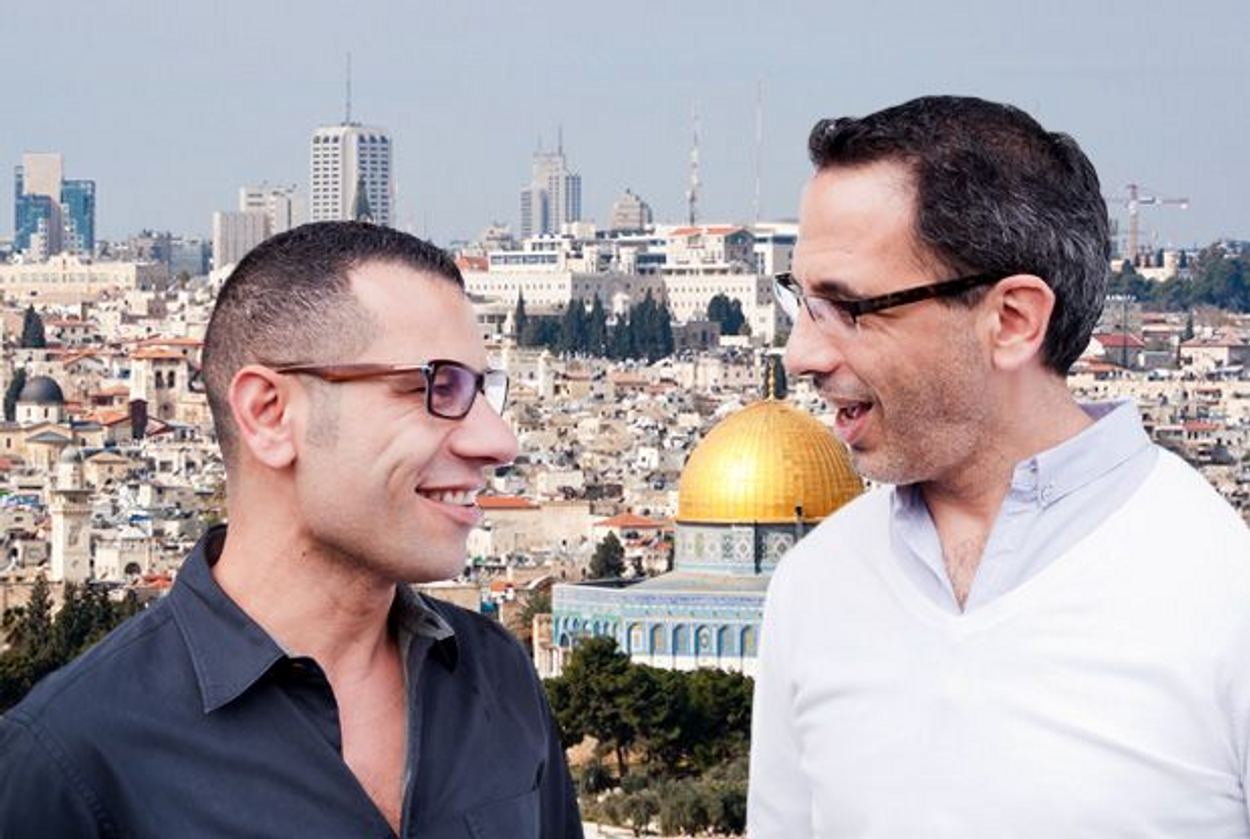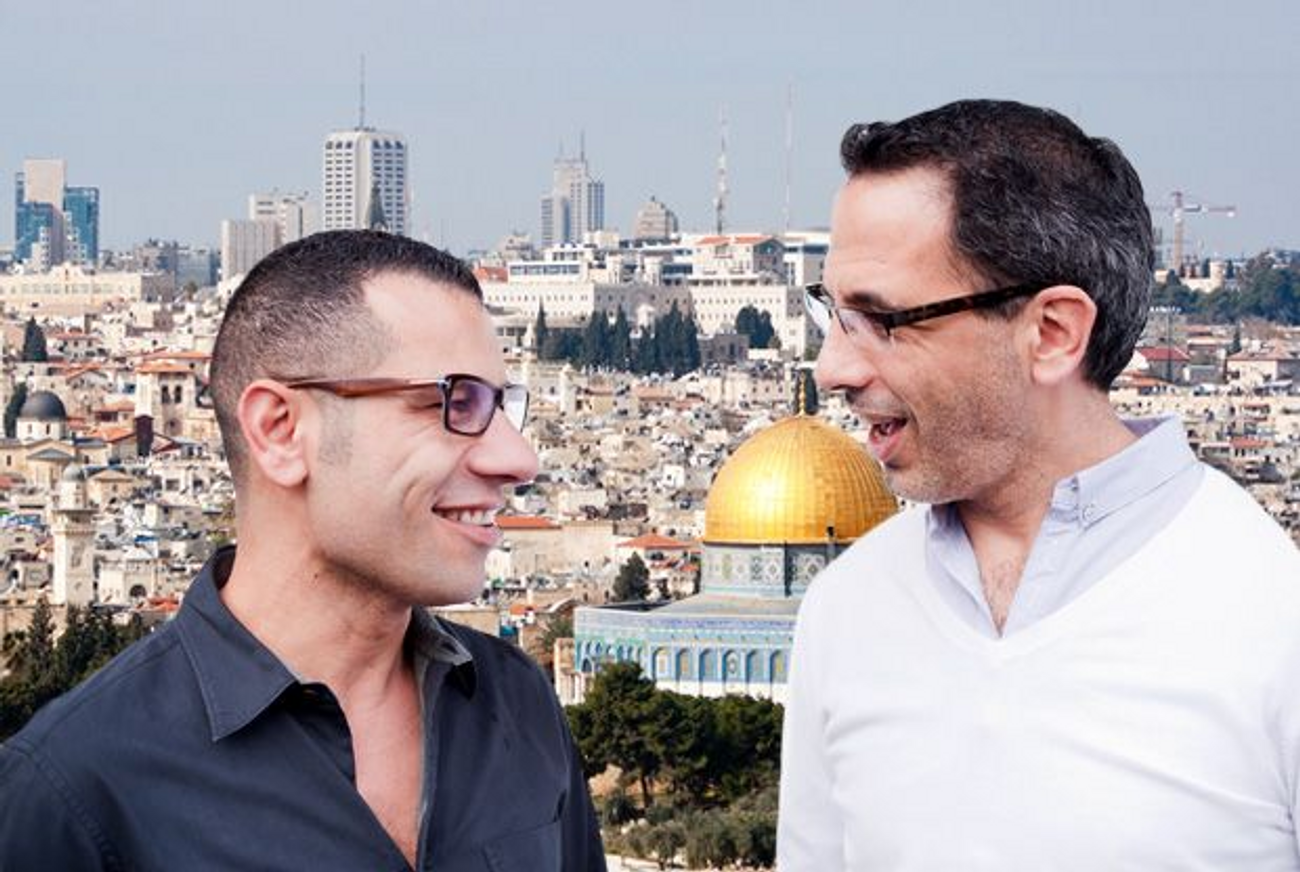The Taste of Jerusalem
Yotam Ottolenghi and Sami Tamimi paint a complex portrait of their hometown’s cuisine in a new cookbook




“When you don’t live somewhere for a long time,” said chef Yotam Ottolenghi, “it’s exciting to come back and relive it.”
Ottolenghi and fellow chef Sami Tamimi live in London, but they revisited their native city for their new collaboration Jerusalem: A Cookbook, in which they re-taste the flavors of their childhoods. In addition to being a nostalgia trip for the authors, Jerusalem is a work of edible anthropology, with recipes from Palestinian culture as well as different Sephardic communities. With its varied recipes, interesting commentary, and dozens of color photos, its depiction of the city is complex and diverse—if still quirky, politically biased, and sadly incomplete.
Born shortly after the city was reunified in 1967, Ottolenghi and Tamimi represent the city’s two halves. Ottolenghi is a child of the West, raised in the middle-class enclave of Ramat Denya as a child of academics: Ottolenghi’s father Michael is a college professor of Italian Jewish descent, his mother Ruth a school principal with a German Jewish background. It was a home where food was important. “Both my parents were very keen cooks,” said Ottolenghi, before adding that he doesn’t feel his Jewish background informs his cooking. “Certainly not Ashkenazi [cuisine],” he said. “If anything, I’m more drawn to Sephardic cooking. It suits the climate and soil better.”
He earned Masters degrees in philosophy and comparative literature and briefly considered an academic career, but when he moved to London in 1997 Ottolenghi realized his true calling. He took cooking courses at the London branch of the famed Cordon Bleu cooking school, where he trained to become a pastry chef. After that, there was no turning back.
In contrast, Tamimi, raised in East Jerusalem, never had any doubts that he was born to cook. The youngest son of a tourism-worker father and a stay-at-home mom, Tamimi developed his love for food in his parents’ kitchen. In Tamimi’s large Arab family—seven kids plus grandparents—there were many mouths to feed, and everyone cooked, including his father. “Forty years ago it was rare for a Palestinian man to cook,” said Tamimi. “My earliest memories are of going to the Arab shuk and of my father, mother, and grandmother cooking all together.” While still in his teens, Tamimi began working at a hotel kitchen. From there he ventured to Tel Aviv, where he became one of the local pioneers of California cuisine as chef at Lilith restaurant.
The 1990s found Tamimi in London, cooking at Baker and Spice, a gourmet food shop run by Tel Avivi Yael Mejiya. One day, Ottolenghi came by the store looking for a job. In a 2009 Gourmet magazine interview, Ottolenghi recalled that their initial conversation took place in English and was about the horrors of English food—especially mince pie. “We couldn’t get over it,” said Ottolenghi. Realizing that they were both Israeli, they soon switched to Hebrew. Since Tamimi has no Arabic accent in Hebrew, Ottolenghi initially mistook him for a Jewish Israeli. To this day, the two still use both languages to communicate.
From that chance encounter, a business partnership was born. In 2002, Ottolenghi and Tamimi got together with a group of partners and opened the first of what would become a chain. Today their business includes three Ottolenghi deli cafes in London, an online store, and NOPI restaurant in London’s fashionable Soho district. Ottolenghi then undertook writing the “New Vegetarian” column for the Guardian, out of which grew his first cookbook, Ottolenghi, which he coauthored with Tamimi in 2008. That was followed in 2010 by vegetarian best-seller Plenty, which Ottolenghi wrote on his own.
Now Tamimi is back on board. This new book—their first to include meat dishes—is a full collaboration between the two. “We did everything together,” said Tamimi.
During the two-year period that Jerusalem was in production, Ottolenghi made frequent trips to Israel. He also spent several weeks surveying Jerusalem’s local food scene and meeting cooks while working on a BBC television documentary Jerusalem on a Plate. Tamimi, on the other hand, didn’t visit at all. (Though his parents are listed in the acknowledgements, Tamimi refused to discuss his relationship with them.) Instead, Ottolenghi staffer Nomi Abeliovich stepped in, spending 18 months collecting recipes and information for the book. “She met cooks, mostly women from different backgrounds—Tripoli, Syria, Morocco, Tunisia—and cooked with them,” said Ottolenghi. While some of the recipes are long, Ottolenghi’s instructions are very clear and give you the sense that he’s your friend guiding you as you cook.
For two chefs who laud cooking and eating as a “hedonistic pleasure,” Ottolenghi and Tamimi are delightfully health-conscious in their approach. In their kitchen, canned foods and artificial ingredients don’t exist. Some purists would object to their love of frying, but even that is done gently with relatively small amounts of oil. Instead of grandstanding about vitamins and minerals, Ottolenghi and Tamimi coax us into healthy eating by alchemizing beets, spinach, kohlrabi, beans, and grains into amazing, edible bouquets stylishly photographed by Jonathan Lovekin, who was also the photographer for Plenty.
But as current as it purports to be, this cookbook doesn’t cover the popular food trend known as Jerusalem cuisine. “Jerusalem cuisine involves cooking with local ingredients that have biblical roots,” said Moshe Basson, owner of Eucalyptus—a restaurant in the Hutzot Hayotzer artists’ quarter, right outside the walls of Jerusalem’s Old City—and one of the movement’s leading proponents. Though some biblical ingredients find their way into this book, they are never acknowledged as such, nor are biblical or Talmudic quotations included in the commentary. (Religious observances also don’t come up in the book’s text or photos, in fact, even though Jerusalem pulses with religious observance.) A few of the recipes feature milk-and-meat combinations or shellfish, although kashrut and hallal observers will at least be pleased to note that there isn’t any pork.
More to the point, Both Ottolenghi and Tamimi seem politically quite squarely aligned with the Palestinians, a community that “bears the burden with no sign of regaining control over its destiny,” as they write in their introduction—a description disorienting and depressing for its one-sidedness. Most of Lovekin’s beautiful pictures are of the Old City’s Muslim quarter: Arab women sampling pastries in the souk, grim looking old men in mildewed rooms puffing on water pipes, a young child rushing through a grey stone alleyway. West Jerusalem, with its tree-lined streets and funky gentrified homes, scarcely makes an appearance; the second intifada’s bloody attacks on West Jerusalem’s Machne Yehuda market and several of the area’s most popular restaurants are also left out. It’s an omission indicative of this beautiful and useful cookbook’s main shortcoming: The city may be reunified, but parts of it still seem to be missing here.
Carol Ungar’s writing has appeared in Next Avenue, Forbes, NPR, the Jerusalem Post Magazine, and Fox News. She also leads memoir writing workshops on Zoom.